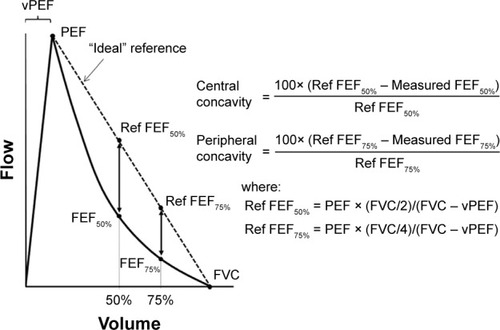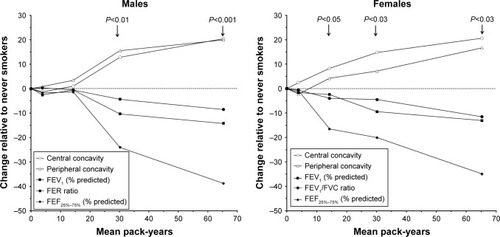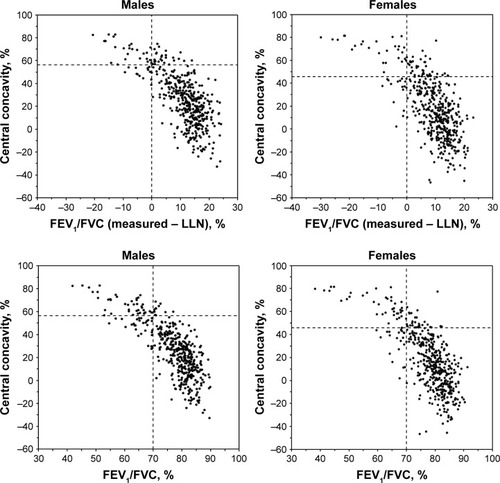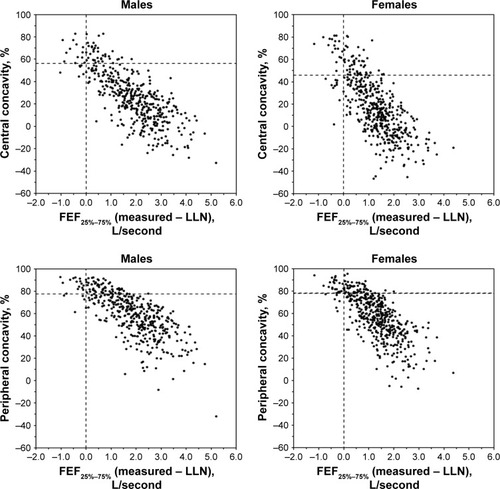Figures & data
Figure 1 Variables used to quantify central and peripheral concavities (see text).
Abbreviations: FEF25%–75%, forced expiratory flow between 25% and 75% of the FVC; FVC, forced vital capacity; PEF, peak expiratory flow; vPEF, volume expired to peak expiratory flow.

Table 1 Descriptive data for the sample
Figure 2 Relationship between lifetime tobacco consumption and post-BD spirometry and concavity, expressed as the difference relative to never smokers (nil pack-years).
Abbreviations: FEF25%–75%, forced expiratory flow between 25% and 75% of the FVC; FEV1, forced expiratory volume in 1 second; FVC, forced vital capacity; post-BD, post-bronchodilator.

Table 2 Spearman rank correlations for associations between post-BD concavity and spirometric variables
Table 3 Descriptive data for subjects classified as normalTable Footnotea
Table 4 Prevalence of abnormal post-BD concavities (central and peripheral) and abnormal spirometric variables
Figure 3 Post-BD relationships between central concavity and FEV1/FVC in males (n=424) and females (n=466).
Notes: The horizontal dotted line is the ULN for central concavity. The vertical dotted line in the two upper plots is the LLN for FEV1/FVC from Hankinson et alCitation34 and for the lower two plots, it is the fixed LLN of 70% from GOLD.Citation1 A negative value for FEV1/FVC indicates values below the LLN.
Abbreviations: FEV1, forced expiratory volume in 1 second; FVC, forced vital capacity; GOLD, global initiative for chronic obstructive lung disease; LLN, lower limit of normal; Post-BD, post-bronchodilator; ULN, upper limit of normal.

Figure 4 Post-BD relationships between peripheral concavity and FEV1/FVC in males (n=424) and females (n=466).
Notes: The horizontal dotted line is the ULN for peripheral concavity. The vertical dotted line in the two upper plots is the LLN for FEV1/FVC from Hankinson et alCitation34 and for the lower two plots, it is the fixed LLN of 70% from GOLD.Citation1 A negative value for FEV1/FVC indicates values below the LLN.
Abbreviations: FEV1, forced expiratory volume in 1 second; FVC, forced vital capacity; GOLD, global initiative for chronic obstructive lung disease; LLN, lower limit of normal; Post-BD, post-bronchodilator; ULN, upper limit of normal.

Figure 5 Post-BD relationships between central and peripheral concavities and FEF25%–75% in males (n=424) and females (n=466).
Abbreviations: FEF25%–75%, forced expiratory flow between 25% and 75% of the FVC; LLN, lower limit of normal; Post-BD, post-bronchodilator; ULN, upper limit of normal.

Table 5 Sensitivity and specificity analyses of concavity for breathlessness on moderate activity (which occurred in 20% of the total population) in males and females whose FEV1/FVC or FEF25%–75% or FEV1/FVC ratio + FEF25%–75% were normal
